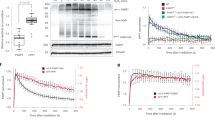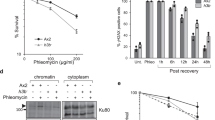Abstract
Recent studies report serine ADP-ribosylation on nucleosomes during the DNA damage response. We unveil histone H3 serine 10 as the primary acceptor residue for chromatin ADP-ribosylation and find that specific histone acetylation marks block this activity. Our results provide a molecular explanation for the well-documented phenomenon of rapid deacetylation at DNA damage sites and support the combinatorial application of PARP and HDAC inhibitors for the treatment of PARP-dependent cancers.
This is a preview of subscription content, access via your institution
Access options
Access Nature and 54 other Nature Portfolio journals
Get Nature+, our best-value online-access subscription
$29.99 / 30 days
cancel any time
Subscribe to this journal
Receive 12 print issues and online access
$259.00 per year
only $21.58 per issue
Buy this article
- Purchase on Springer Link
- Instant access to full article PDF
Prices may be subject to local taxes which are calculated during checkout


Similar content being viewed by others
References
Ray Chaudhuri, A. & Nussenzweig, A. Nat. Rev. Mol. Cell Biol. 18, 610–621 (2017).
Daniels, C. M., Ong, S. E. & Leung, A. K. Mol. Cell 58, 911–924 (2015).
Ogata, N., Ueda, K., Kawaichi, M. & Hayaishi, O. J. Biol. Chem. 256, 4135–4137 (1981).
Messner, S. & Hottiger, M. O. Trends Cell Biol. 21, 534–542 (2011).
Bonfiglio, J. J. et al. Mol. Cell 65, 932–940.e6 (2017).
Gibbs-Seymour, I., Fontana, P., Rack, J. G. M. & Ahel, I. Mol. Cell 62, 432–442 (2016).
Krishnakumar, R. & Kraus, W. L. Mol. Cell 39, 8–24 (2010).
Amé, J. C. et al. J. Biol. Chem. 274, 17860–17868 (1999).
Pommier, Y., O’Connor, M. J. & de Bono, J. Sci. Transl. Med. 8, 362ps17 (2016).
Jenuwein, T. & Allis, C. D. Science 293, 1074–1080 (2001).
Palazzo, L. et al. eLife 7, e34334 (2018).
Leidecker, O. et al. Nat. Chem. Biol. 12, 998–1000 (2016).
Fontana, P. et al. eLife 6, e28533 (2017).
Polo, S. E. & Jackson, S. P. Genes Dev. 25, 409–433 (2011).
Dann, G. P. et al. Nature 548, 607–611 (2017).
Kim, M. Y., Mauro, S., Gévry, N., Lis, J. T. & Kraus, W. L. Cell 119, 803–814 (2004).
Mao, Z. et al. Science 332, 1443–1446 (2011).
Miller, K. M. et al. Nat. Struct. Mol. Biol. 17, 1144–1151 (2010).
Tjeertes, J. V., Miller, K. M. & Jackson, S. P. EMBO J. 28, 1878–1889 (2009).
Michishita, E. et al. Nature 452, 492–496 (2008).
Martello, R. et al. Nat. Commun. 7, 12917 (2016).
Hassa, P. O. et al. J. Biol. Chem. 280, 40450–40464 (2005).
Muthurajan, U. M. et al. Proc. Natl. Acad. Sci. USA 111, 12752–12757 (2014).
Min, A. et al. Breast Cancer Res. 17, 33 (2015).
Ha, K. et al. Oncotarget 5, 5637–5650 (2014).
Nguyen, U. T. et al. Nat. Methods 11, 834–840 (2014).
Luger, K., Mäder, A. W., Richmond, R. K., Sargent, D. F. & Richmond, T. J. Nature 389, 251–260 (1997).
Gil, R., Barth, S., Kanfi, Y. & Cohen, H. Y. Nucleic Acids Res. 41, 8537–8545 (2013).
Wang, W. W., Zeng, Y., Wu, B., Deiters, A. & Liu, W. R. ACS Chem. Biol. 11, 1973–1981 (2016).
Acknowledgements
We thank current members of the Muir laboratory as well as C.D. Allis for discussions and comments. We also thank the Princeton University Sequencing Core Facility and C. Arrowsmith (University of Toronto) for the SIRT6 expression plasmid. This work was supported by National Institutes of Health (NIH) Grants R37 GM086868, R01 GM107047 and P01 CA196539. G.P.L. and K.L.D. were supported by NIH Research Service Awards (1F32GM110880 and 5F32CA206418, respectively).
Author information
Authors and Affiliations
Contributions
G.L. and K.L.D. performed all experiments. G.P.D. assisted with DNA barcode sorting following high-throughput DNA sequencing. G.L., K.L.D., and T.W.M. analyzed all data and wrote the manuscript.
Corresponding author
Ethics declarations
Competing interests
The authors declare no competing interests.
Additional information
Publisher’s note: Springer Nature remains neutral with regard to jurisdictional claims in published maps and institutional affiliations.
Supplementary information
Supplementary Text and Figures
Supplementary Table 1, Supplementary Figures 1–26
Supplementary Dataset 1
Mononucleosome library binding and ADP-ribosylation activity measurements for PARP1–HPF1 and PARP2–HPF1.
Rights and permissions
About this article
Cite this article
Liszczak, G., Diehl, K.L., Dann, G.P. et al. Acetylation blocks DNA damage–induced chromatin ADP-ribosylation. Nat Chem Biol 14, 837–840 (2018). https://doi.org/10.1038/s41589-018-0097-1
Received:
Accepted:
Published:
Issue Date:
DOI: https://doi.org/10.1038/s41589-018-0097-1
This article is cited by
-
Interrogating epigenetic mechanisms with chemically customized chromatin
Nature Reviews Genetics (2024)
-
Toxic PARP trapping upon cAMP-induced DNA damage reinstates the efficacy of endocrine therapy and CDK4/6 inhibitors in treatment-refractory ER+ breast cancer
Nature Communications (2023)
-
Linking DNA repair and cell cycle progression through serine ADP-ribosylation of histones
Nature Communications (2022)
-
The role of patient-derived ovarian cancer organoids in the study of PARP inhibitors sensitivity and resistance: from genomic analysis to functional testing
Journal of Experimental & Clinical Cancer Research (2021)
-
Efficacy and mechanism of the combination of PARP and CDK4/6 inhibitors in the treatment of triple-negative breast cancer
Journal of Experimental & Clinical Cancer Research (2021)



